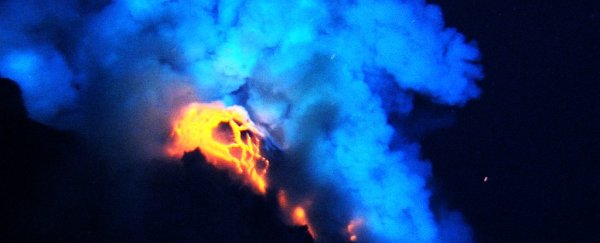Off the coast of Hawaii, nearly a kilometre beneath the waves, an active volcano bubbles, spewing heat from beneath the seabed. This is the Lō'ihi Seamount, and NASA is studying it in the hopes of learning more about extraterrestrial life.
Saturn has two moons that are currently being eyeballed as the strongest candidates for life within the Solar System.
Both are thought to have liquid oceans, sloshing about under icy crusts, far from the warmth of the Sun. And, critically, both are also believed to have hydrothermal vents on their seafloors, responsible for geysers we have observed on both moons.
We have our own hydrothermal vents here on Earth, which are often associated with volcanic activity. Back when the world was almost entirely covered with oceans, some scientists believe that the first life on Earth could have sprung up around these vents.
The vast majority of life on Earth is dependent on photosynthesis, the process whereby plants make energy from sunlight. But on hydrothermal vents, often below the reach of the Sun's rays, the process is different.
The creatures there rely on chemosynthesis - the bacteria harnessing chemical energy, such as the reaction between hydrogen sulfide from the vent, and oxygen from the seawater around them, to produce sugar molecules - food.
Once bacteria exists, other animals can feed on it and the nutrients it produces, and thus an entire food chain can thrive down there in the dark. Just as the hydrothermal vents on Europa and Enceladus would be very much in the dark.
So this is why hydrothermal vents are thought to make an excellent analog for what we might find on Saturn's moons - especially since the discovery of their geysers, which hinted there may be chemical interactions down on those strange seafloors along the lines of what we see here on Earth.
So far, NASA's research has focused on hydrothermal vents on the edges of tectonic plates. They've also looked at very deep environments such as the Von Damm hydrothermal vent field at 2,300 metres (7,500 feet) and the Piccard field at over 4,900 metres (16,000 feet).
The Lō'ihi Seamount is just 975 metres (3,200 feet) deep. Not quite in those deep dark depths, but that's not why NASA is studying it.
Lōʻihi is what is known as a hotspot volcano, far from any tectonic edges. Although it seeps molten magma into the waters around it, it's thought that it doesn't get as hot as plate-edge regions - and this might make it closer to temperatures on Enceladus and Europa.
The project to explore the volcano is called the Systematic Underwater Biogeochemical Science and Exploration Analog, or SUBSEA, and it's embarking aboard the NOAA exploration vessel Nautilus.
Researchers will be studying the waters around the volcano, sampling it across a range of temperatures and pressures. This information will then be added to the existing data on hydrothermal vents to try and put together a more complete picture of what we might find on those icy moons - if we can ever get there.
